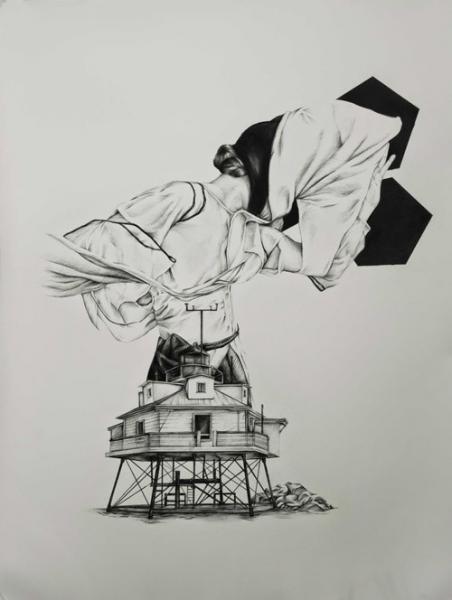In Rania Emmanouilidou’s works, human forms are immobilised; perpetually frozen on the verge of some movement, whose before and after are insignificant. As are the reasons that set this movement into gear. Here, there’s only the verge that both signifies and manifests. The verge fulfils Emmanouilidou’s characters. They were born with the verge; they carry the verge. They are full with gestation. As if this is their only occupation: they carry gestation itself. Why?

Untitled.
If our adherence to the verge favours a state of precarious balancing and preparation, meaning expectation, then these human forms are probably bracing themselves for something, they are expecting, hoping for something. For what? I guess Emmanouilidou’s characters are anticipating their future potential – and the extension of this future potential in perpetuity. This is a hedonistic extension, secretly looking towards the preservation of an internal hope – humankind’s most basic hope: the hope for transformation.


Marionette Player.
Perhaps this is why they postpone settling into a definitive position and stance. Perhaps this is why it is not obvious whether these figures are willingly hiding from us or whether someone is concealing them; whether they are turning a blind eye or whether they are blinded by someone else; whether they know or not. They experience the expansion of the extension in a way in which –if they knew the word– they would call “stoic”. But they don’t know this word – they don’t know any word. They sense though, I guess, that around them –a while before or a while after the verge– the world’s corners, the dangers and the terror, are lurking, always threatening. They might even know that hostilities of all kinds pre-existed or will exist anew out there. However, the figures themselves are made with the absence of white: they are well familiar with black. This is why they gladly bear their prolongation, they are filled with the mechanism of preparation, they live in the limbo of suspension.


Farewell.
This borderline situation, however, is in no case stemming from cowardice or fear. On the contrary. Living under the shelter of extension, postponing for a while longer – and yet a while longer – their movement, those figures slowly and silently weave – through this moratorium – their exalted oratorio: a deeply existential wish. They look towards their ontological growth.
Emmanouilidou knows that still life’s “natura morte” is nothing but the motionless but condensed “still life” of life.
This immobility is rampant.
* Vasilis Amanatidis is a poet, translator and art historian
Article courtesy of The Greek Foundation.
